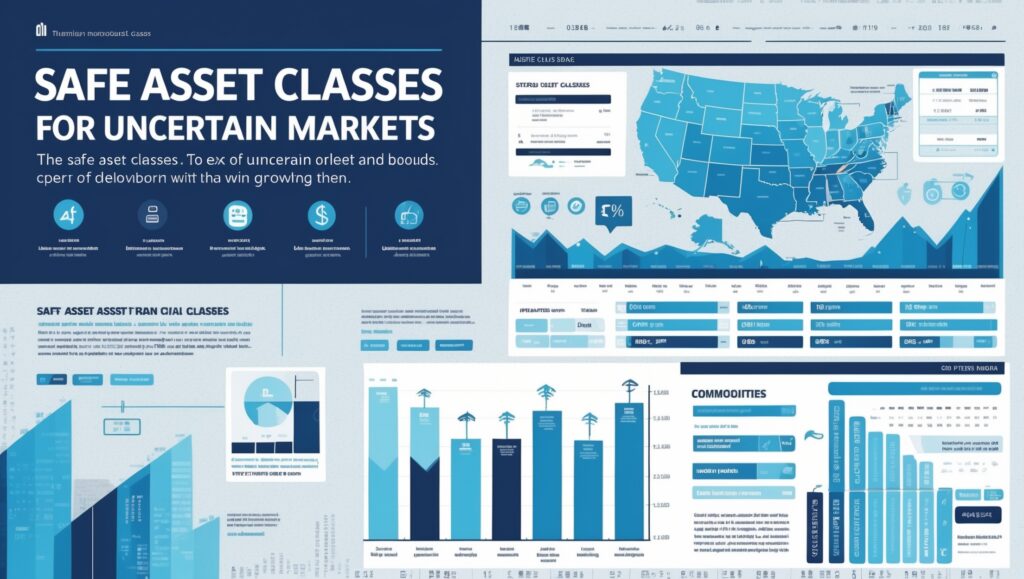Safe Asset Classes for Uncertain Markets
Safe Asset Classes for Uncertain Markets
Discover the safest asset classes for uncertain markets, how I personally navigate risk, and strategies to protect your portfolio while still growing your wealth. Learn how to invest smartly during volatility and economic uncertainty.
Learn How To Pay Bills with Stocks.

Table of Contents
Why Investing Safely Matters
In today’s unpredictable markets, I’ve realized the importance of focusing on safe asset classes. Volatility can shake confidence, and without proper planning, investments can lose significant value.
For me, safety doesn’t mean avoiding growth entirely. Instead, it’s about protecting capital while positioning for steady returns. By allocating funds into safer assets, I can sleep at night knowing my portfolio isn’t overly exposed to risk.
I also learned that many beginner investors overlook the balance between risk and reward. Chasing high returns without considering safe assets can lead to big losses, which is why I prioritize a mix of secure investments in uncertain times.
Understanding Risk and Volatility
Before choosing safe assets, I analyze risk and volatility. Risk is not just losing money; it’s the potential of your investment underperforming relative to your goals. Volatility measures how much an asset’s price fluctuates.
I use these concepts to allocate assets strategically. High volatility can offer opportunities, but I only take calculated risks, making sure that a portion of my portfolio remains in low-volatility assets.
Cash and Cash Equivalents
One of the first safe asset classes I turn to is cash and cash equivalents. This includes savings accounts, money market funds, and Treasury bills.
I like this class because it provides liquidity and safety. Even during market crashes, I know my cash is accessible and protected. While the returns are modest, it gives me the freedom to act when opportunities arise.
For those seeking to maintain stability while still earning some interest, I recommend keeping a portion of your portfolio in high-yield savings or short-term Treasuries. This acts as a safety net during turbulent times.
Government Bonds
Another cornerstone of my safe portfolio is government bonds. U.S. Treasury bonds, for example, are considered nearly risk-free because they are backed by the government.
I often use a mix of short-term, medium-term, and long-term bonds to manage interest rate risk while earning reliable income. Bonds provide capital preservation and predictable returns, which are crucial during uncertain markets.
I also include international government bonds selectively. They diversify risk geographically, which can be valuable if one economy faces instability.
High-Quality Corporate Bonds
While government bonds are very safe, I also invest in high-quality corporate bonds from companies with strong credit ratings. These bonds typically offer higher yields while maintaining relatively low risk.
I focus on companies with stable earnings, low debt, and strong market positions. This reduces the likelihood of default and adds an extra layer of safety to my income-focused investments.
Defensive Stocks
Not all stocks are risky. I allocate part of my portfolio to defensive stocks—companies that tend to perform well even during economic slowdowns. Examples include utilities, consumer staples, and healthcare companies.
I like defensive stocks because they provide stability, consistent dividends, and moderate growth. Even when the broader market struggles, these companies often maintain steady cash flows, which helps protect my capital.
Dividend-Paying Stocks
Dividend-paying stocks are another favorite of mine during uncertain markets. Dividends provide passive income that can cushion portfolio declines and give me flexibility to reinvest or withdraw cash as needed.
I look for companies with a history of increasing dividends, low payout ratios, and sustainable business models. These stocks offer both growth potential and income, making them a safer choice in volatile times.
Precious Metals
I also include precious metals like gold and silver in my portfolio. These assets historically serve as a hedge against inflation and market uncertainty.
I usually invest through ETFs or physical holdings, depending on liquidity needs. Precious metals often move independently of stocks and bonds, which adds an extra layer of diversification and security.
Real Estate
Real estate is another safe asset class I consider. While property values can fluctuate, rental income and long-term appreciation provide stability and a hedge against inflation.
I often use REITs (Real Estate Investment Trusts) to gain exposure without the hassle of managing physical properties. REITs provide liquidity, dividends, and diversification across commercial, residential, and industrial real estate.
Diversification: The Key to Safety
The most important principle I follow is diversification. No single asset is completely safe, but by combining cash, bonds, defensive stocks, precious metals, and real estate, I reduce overall portfolio risk.
Diversification helps me navigate uncertainty with confidence, because even if one asset class underperforms, others can balance the impact.
Risk Management Strategies
Beyond asset selection, I also implement risk management strategies. This includes:
- Position sizing – Limiting exposure to any single asset.
- Stop-loss orders – Protecting against unexpected declines.
- Regular rebalancing – Adjusting allocations to maintain target risk levels.
These strategies ensure that my safe asset classes actually serve their purpose: preserving capital during volatile periods.
Monitoring Economic Indicators
I also monitor economic indicators, like inflation, interest rates, and GDP growth. These metrics influence the performance of different asset classes, helping me adjust my allocations proactively.
For example, rising interest rates may impact bond prices, so I adjust my bond holdings accordingly, always aiming to protect my portfolio from unnecessary losses.
Using ETFs to Access Safe Assets
I often use ETFs to gain exposure to multiple safe asset classes efficiently. ETFs allow me to diversify across bonds, dividend stocks, and precious metals without purchasing individual securities.
This approach saves time, reduces costs, and ensures I’m properly diversified in every market condition.
Staying Flexible in Uncertain Markets
Safety also requires flexibility. I keep a portion of my portfolio in liquid, low-risk assets so I can act on opportunities when markets become volatile or when I spot undervalued investments.
Flexibility allows me to take advantage of dips and market dislocations while keeping most of my capital protected.
Want My Full Safe Investing System?
If you want to see exactly how I structure my portfolio with safe asset classes to protect capital and grow wealth in uncertain markets, I share my full strategy in my ebook: Pay Bills with Stocks.
I explain step by step how I combine cash, bonds, defensive stocks, dividends, precious metals, and real estate into a balanced, risk-aware portfolio that generates consistent income even in volatile markets.
Final Thoughts
Safe asset classes are essential for any investor, especially during uncertain economic periods. By focusing on liquidity, stability, and diversification, I can protect my portfolio while still capturing growth opportunities.
For a practical, hands-on guide to building a safe, income-generating portfolio, check out my ebook: Pay Bills with Stocks.

Stay ahead in the stock market! Subscribe to our newsletter and receive exclusive stock flow reports, trading insights, and actionable tips directly in your inbox. Join thousands of traders who get our updates first.







